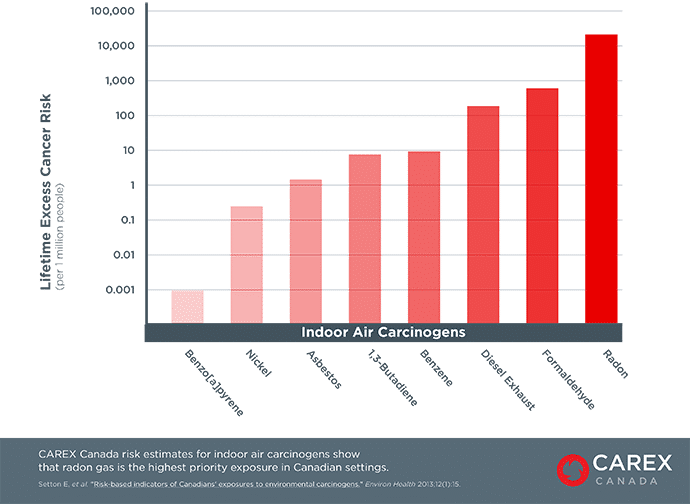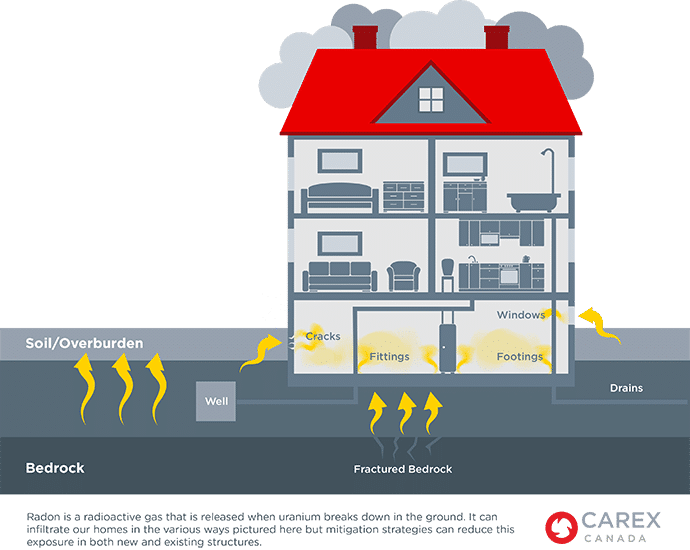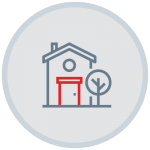Radon Environmental Exposures
Radon Environmental Exposures
Overview
The most important route of radon exposure for the general population is inhalation. Exposure by ingesting drinking water is possible, but there is very little evidence that ingesting radon leads to cancer.[1] CAREX Canada estimates that radon in indoor and outdoor air are sources of elevated cancer risk in Canada (moderate data quality). In fact, risk estimates for indoor air carcinogens show that radon gas is the highest priority exposure in Canadian environmental settings.[2] Environmental radon exposure through indoor dust, drinking water, food, and beverages is considered negligible.
READ MORE...

Radon levels are significantly higher in indoor air compared to outdoor air. In Canada, radon can be found in new and older homes and public buildings, such as hospitals, schools, care facilities, and detention centres.[3] Radon gas enters buildings when the air pressure inside is lower than in the soil surrounding the foundation.[4] This difference in pressure draws air and other gases, including radon, into buildings through cracks and openings in foundations, construction joints, gaps around pipes, sump pumps and drains, windows, or cavities inside walls. Radon can also be found in groundwater from private or small community wells. When this water is agitated through showering, clothes washing, and cooking, radon may be released into the home.[5]

Environmental radon concentrations vary depending on a number of factors including building characteristics (e.g. ventilation and sealing), occupant lifestyle (e.g. using windows or fireplaces), and local geology and soil characteristics.[4] The highest concentrations are found in areas with uranium and thorium ore deposits and granite formations (which have naturally high concentrations of uranium).[1] Radon levels in buildings also vary across seasons, and can change significantly in 24 hours (by a factor of two or three).[3] The highest levels usually occur in winter because windows and doors are kept closed, sealing buildings and therefore decreasing ventilation. When buildings are sealed to conserve energy, higher levels of radon can accumulate as well.[6]
Most Canadian homes contain some level of radon gas.[4] In a cross-country survey of radon concentrations in homes conducted by Health Canada from 2009 to 2011, 6.9% of homes tested had indoor radon concentrations above the current Canadian guideline of 200 Bq/m3.[7] Results indicate that radon levels vary significantly across the country. Indoor radon is more prevalent in a number of regions, but no areas of the country are ‘radon free’. Saskatchewan, Manitoba, New Brunswick, and the Yukon had the highest percentages of participant homes testing above the radon guideline.
On average, Canadians receive a typical yearly dose of about 1.0 mSv from inhaling radon and its decay products.[8] This dose varies greatly across the country according to the geological composition of the area; for example, in Vancouver the average dose is 0.2 mSv/year, but in Winnipeg it is 2.2 mSv/year.
Mapping
Radon levels in homes vary across Canada. The national map below summarizes radon measurements from the Cross Canada Radon Survey (Phase I & II), highlighting the percentage of home radon measurements in each health region above the current Canadian guideline of 200 Bq/m3. The table shows the percentage of tested homes in each province and territory that fall with different levels. The World Health Organization reference level is currently 100 Bq/m3, and the current Canadian guideline is 200 Bq/m3.
Percent of home radon measurements above 200 Bq/m3 by health region
2009-2011 Cross Canada Radon Survey – Phase 1 & 2 results
Percent of home radon measurements by province/territory and level
2009-2011 Cross Canada Radon Survey – Phase 1 & 2 results
Cancer Risk Estimates
Potential lifetime excess cancer risk (LECR) is an indicator of Canadians’ exposure to known or suspected carcinogens in the environment. When potential LECR is more than 1 per million in a single pathway, a more detailed risk assessment may be useful for confirming the need to reduce individual exposure. If measured levels of radon in relevant exposure pathways (outdoor air and indoor air) decrease, the risk will also decrease.
Potential LECR due to exposure to radon is calculated by combining data on measured concentrations in outdoor air and indoor air with standard inhalation rates to calculate lifetime cumulative exposure. Multiplying the estimated cumulative intake by a unit risk factor produces an estimate of the lifetime excess cancer risk. Only the US Environmental Protection Agency (US EPA) has a published unit risk factor for radon.
The calculated lifetime cumulative exposure and LECR results for radon are provided in the tables below. For more information on supporting data and sources, click on the Methods and Data tab below.
Calculated Lifetime Cumulative Exposure
Lifetime Excess Cancer Risk (per million people)
*LECR based on average intake x cancer potency factor from each agency
Compare substances: Canadian Potential Lifetime Excess Cancer Risk, 2011
The data in this table are based on average intake and Health Canada’s cancer potency factor, assuming no change in measured levels. When Health Canada values are not available, United States Environmental Protection Agency values are used.
Click the second tab to view LECR data.
**Exposure not applicable: For indicated pathways, substance not present, not carcinogenic, or exposure is negligible
**Gap in data: No cancer potency factor or unit risk factor, or no data available
IARC Group 1 = Carcinogenic to humans, IARC Group 2A = Probably carcinogenic to humans, IARC Group 2B = Possibly carcinogenic to humans
NOTE: Chromium (hexavalent) estimates assume that 5% of total chromium measured in outdoor air is hexavalent and 8% total chromium measured in indoor dust is hexavalent.
Potential LECR assumes exposure occurs at the same level, 24 hours per day, for 70 years. This is rarely true for any single individual, but using a standard set of assumptions allows us to provide a relative ranking for known and suspected carcinogens across different exposure routes. While ongoing research continually provides new evidence about cancer potency and whether there is a safe threshold of exposure, our approach assumes there are no safe exposure levels.
Methods and Data
Our Environmental Approach page outlines the general approach used to calculate lifetime excess cancer risk estimates and includes documentation on our mapping methods. The documents below outline (1) the specific methods for radon lifetime excess cancer risk estimate calculations and (2) the data sources and data quality for radon estimates.
(1) LECR Methods – Radon [PDF]
(2) Supplemental data – Radon [PDF]
Sources
Subscribe to our newsletters
The CAREX Canada team offers two regular newsletters: the biannual e-Bulletin summarizing information on upcoming webinars, new publications, and updates to estimates and tools; and the monthly Carcinogens in the News, a digest of media articles, government reports, and academic literature related to the carcinogens we’ve classified as important for surveillance in Canada. Sign up for one or both of these newsletters below.
CAREX Canada
School of Population and Public Health
University of British Columbia
Vancouver Campus
370A - 2206 East Mall
Vancouver, BC V6T 1Z3
CANADA
As a national organization, our work extends across borders into many Indigenous lands throughout Canada. We gratefully acknowledge that our host institution, the University of British Columbia Point Grey campus, is located on the traditional, ancestral and unceded territories of the xʷməθkʷəy̓əm (Musqueam) people.



